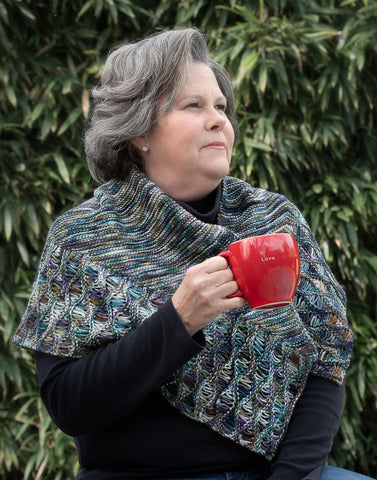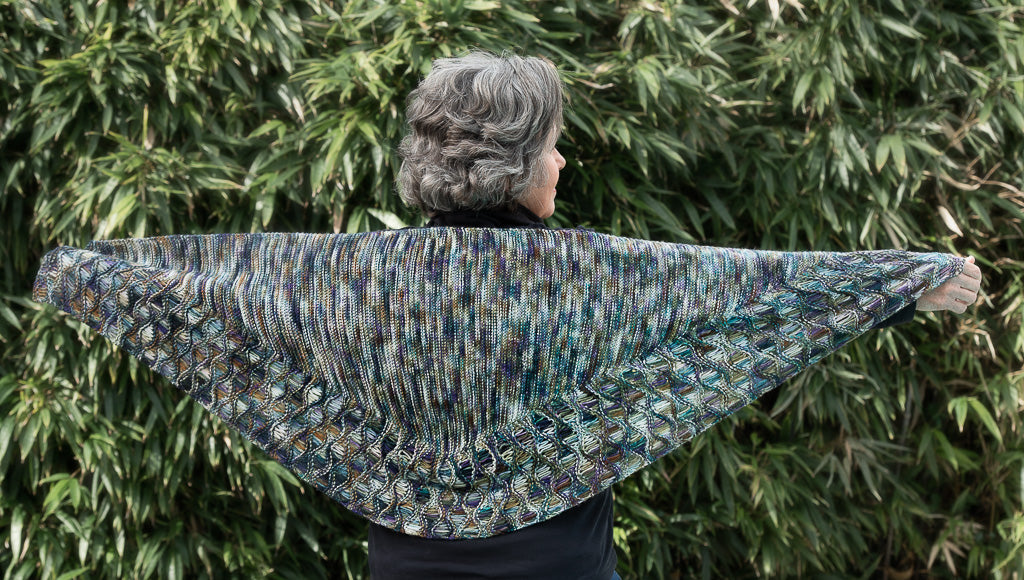We were intrigued when designer Jennifer Dassau sent us her proposal for the UltiFlex shawl (now part of our Winter 2021 Pattern Collection). Yes, we all understand that many shawls can be knit in thicker (or finer) yarns, but most of the time, the stitch patterning looks best when worked in the yarn specified. UltiFlex, however, is designed to accommodate a variety of yarn weights as well as skein sizes. We hope you'll give it a whirl!
We recently spoke with Jennifer to learn a bit more about her background and her designs.
Miss Babs (MB): How long have you been a designer, and how did you start?
Jennifer Dassau (JD): I’ve been an Indie knitwear pattern designer for about 10 years. I taught myself to knit when my son was a baby, and pivoted quickly into designing things for myself. After a while, I would occasionally create patterns for them and put those up on Ravelry. Coming from a hybrid background as a fashion production specialist, and prior to that an attorney, I found that I really liked not only creating wearables but also writing the instructions for making them. So I became more adventurous in my designing, in terms of exploring a technique or a theme that interested me; I started focusing on the elements of the process as well as the finished object.
MB: How did you come up with the design for UltiFlex?
JD: The Miss Babs brief emphasized interesting but uncomplicated stitches, and knit-til-you-run-out-of-yarn patterns. I design shawls with all kinds of constructions, but often come back to these sorts; some of my favorite sideways-knit designs are Picabeau and Venomous Tentacula, and I love a boomerang shape like Crossfire, which is endlessly scalable. For this call, I immediately thought of a sideways knit shawl, where you increase until half the yarn is used up, then decrease again back to a few stitches with the remainder.
I wanted a relaxing garter stitch base, with an exciting, but easy, dramatic edging. After swatching a few possibilities, I chose a simple yet unusual technique of undulating dropped stitches, with a small repeat that was easy to memorize and didn’t require a chart.

MB: We like UltiFlex for its versatility--you really can make this in any yarn.
JD: I really like that you can use almost any base successfully to make UltiFlex, from a smooth plied yarn like Yummy 2-Ply to a luxurious silk blend such as Killington. Differing yardage between bases doesn’t matter, since the shallow triangle shape works as a small shawlette or a huge voluminous wrap.
I think knitters can be confident in getting a beautiful result regardless of which base they choose. If you want a heavier shawl for warmth, Big Silk or any of the dk bases would work; I think UltiFlex would be fabulous in Killington. Any sport or fingering weight would make a super versatile wrap, and you could really go luxe with cashmere in Caroline or Sojourn. And for a big lightweight wrap, you could use laceweight Dulcinea or Yet. Even bulky K2 could make a really interesting kind of statement piece with big impact – but I might suggest going with at least two skeins in order to make a wearable size.
As for fiber, the garter stitch suits merino, silk and cashmere, and any blend thereof will work. The only bases I would avoid are a mohair such as Moonglow, or anything holding two strands together; in each case, the dropped stitches won’t be shown to best advantage.
MB: When you substitute yarns, though, gauges change. How will that affect UltiFlex?
JD: Yes, when you substitute yarn, your gauge will change. Knitters can follow the UltiFlex pattern at any gauge, but as always, a smaller/larger gauge will result in a smaller/larger finished object, and use potentially a different amount of overall yardage. With UltiFlex, it’s relatively easy to control the size - particularly the length – because half the yardage represents the midway point. To maximize your yardage, work the Increase section until half is used, then begin the Decrease section. If you want a certain finished size, work the Increases until the shawl is half your intended length, then begin the Decreases.
It's also important to consider needle size when working at a different gauge. I wrote the pattern for sport weight yarn on a needle size larger than the usual range – US 6, rather than US 3-5. This is typical for shawls, as the larger needle size gives you a relaxed and drapey fabric. You can safely apply the same principle, and size up several needle sizes from what’s recommended on the yarn label, if you’re using finer yarns; however, at dk weight and certainly above, you might want to use the recommended needle, or one only 1 or 2 sizes larger. This is to balance the open edging with the relaxed garter stitch fabric of the body. If your needle size is too large, the dropped stitches might be too loose or floppy.
So, even though this is a shawl, I do recommend doing a gauge swatch so you're happy with the substance of the edging and the drape of the body. When swatching, look for a pleasing result in the dropped stitch fabric to guide your decision about how much to size up your needles.

MB: We also appreciate that UltiFlex looks great in both monochromatic colorways as well as variegated ones.
JD: I find that the texture of garter stitch always looks better than smooth stockinette with variegateds, because the stitches are disoriented in alternating rows of knits and purls rather than in a uniform presentation of all knits (or purls on the WS). This slightly off-kilter positioning helps to break up color blobs. Similarly in the edging, the dropped stitches are highly effective at visually moving apart runs of color, and mixing up any pooling.
MB: Jennifer, thank you so much for your time. We're delighted with Ultiflex, and think our knitters will agree that it's definitely a "must-knit" for those beautiful single skeins of yarn we all have in our stash.
JD: Thank you! As crafters, we like using our precious skeins whether they’re wildly parti-colored or a beautiful semi-solid, and we also like the flexibility to make an awesome project, even if we don’t have exactly the “right” weight of yarn or amount of yardage. Designing UltiFlex gave me an opportunity to focus on solving those needs, and I’m so happy for the chance to chat about creating the design.
You can find Jennifer's designs on her Ravelry Designer page and her Payhip store; her website is https://jenniferdassau.com/.
~~~
We've always loved playing with shawl patterns to change the size and gauge - one of our favorite examples of this is Martina Behm's Hitchhiker, which was written for a fingering weight yarn. By sizing it up to Yowza - a DK weight - we were able to get a bigger, squishier shawl. You can see some examples of Hitchhiker projects at various gauges in our Project Gallery.
Have you played with gauge and needle size on accessory projects? How were the results?

